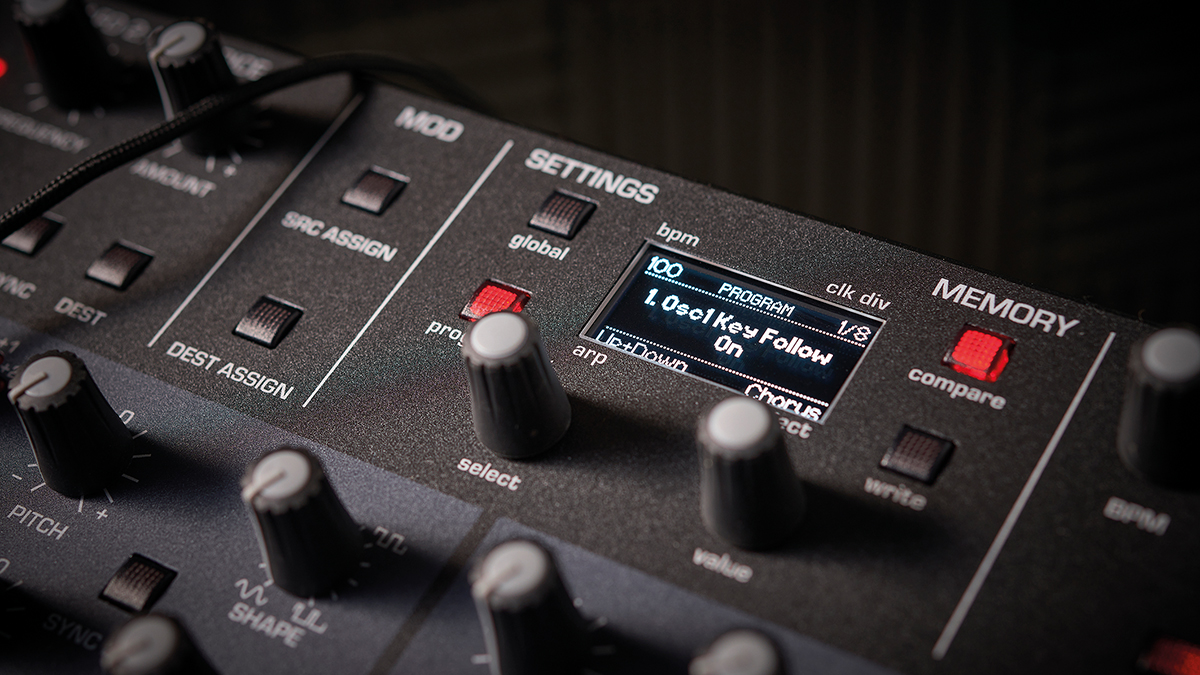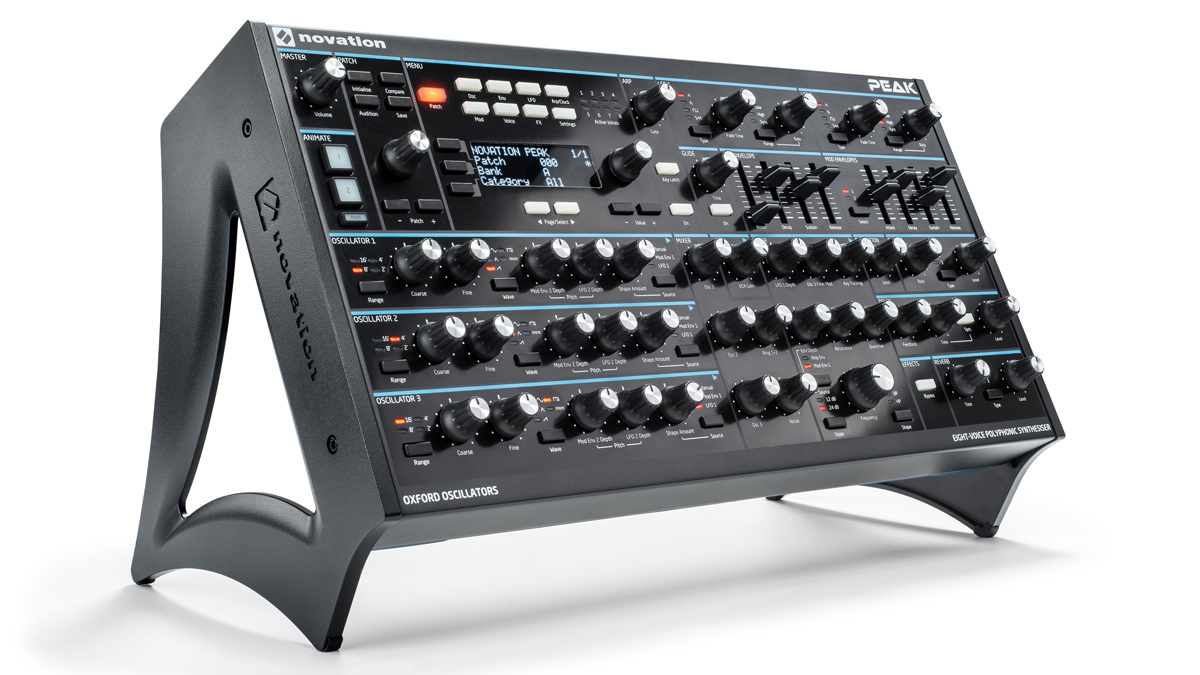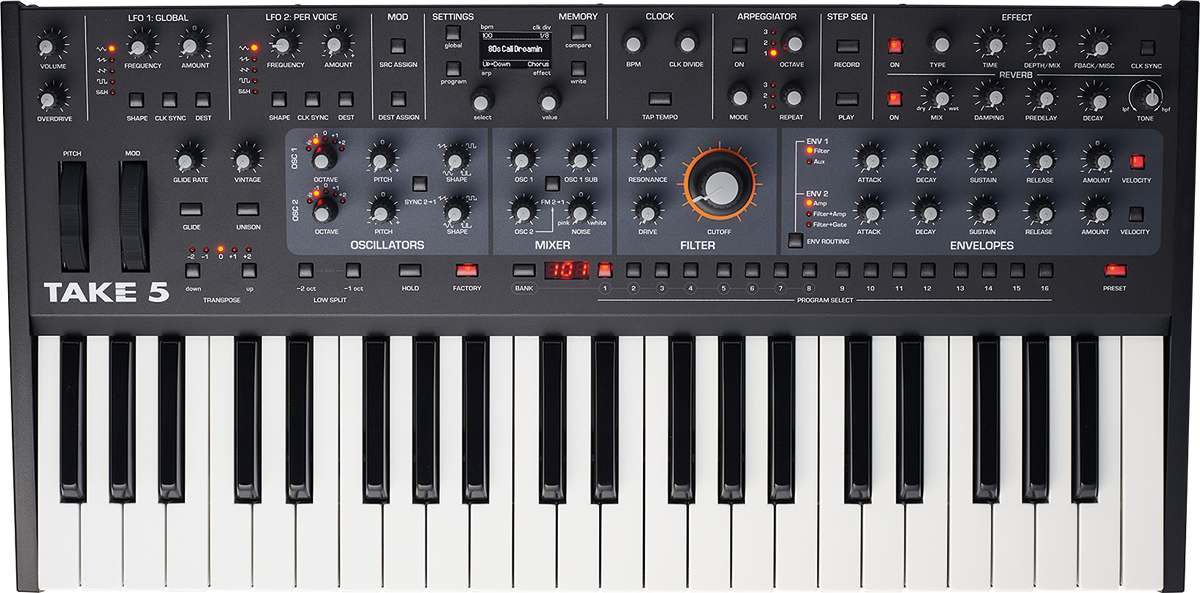MusicRadar Verdict
Take 5 is very much its own synth trying to make its own way in the world. And it’ll do just that. A compact poly with fantastic sounds
Pros
- +
Fantastic, compact design and build.
- +
In-depth modulation features, sequencer and arpeggiator give it a modern feel.
- +
Low Split feature allows you to extend the keyboard range.
- +
Quality Prophet-5 ingredients allowed to blossom with newer features.
Cons
- -
Five voices will not be enough for some.
MusicRadar's got your back
Sequential Take 5: What is it?
Pre-release, the Take 5 was rumoured to be a cheap Prophet-5; then when the first models arrived, we heard that it was a Sequential in Novation clothing, the first product to arise from the purchase of Sequential by the Focusrite group, which also owns Novation. The truth is, it’s none, and all of the above…
Take 5 has analogue ingredients with digital controls and effects. With its name, five notes of polyphony, two analogue VCOs and a Prophet-5 style filter, you can understand the comparisons with the latest Rev 4 of Sequential’s classic Prophet-5 line. But Take 5 grabs that greatness and is unconstrained by any reputation, so it’s doing what the heck it likes with it, creating a synth very much for the 2020s rather than emulating one from the late ’70s. It really is its own synth, then, and for a very decent price, all things considered.
We certainly wouldn’t have had a problem if Take 5 indeed was a cheap Sequential in a Novation case, but it actually feels very much like a four-figure synth – very solid and well made. There’s a mix of incremental pots, easy to turn for distinct parameters like bpm, effect type, arpeggiator and octave, and continuous controllers for options like envelope and filter parameters. These are somewhat stiffer, but I’d expect them to loosen over time.
There’s a fabulous large Filter Cutoff dial in the centre of the synth which demands, and will receive, full attention. Pressing down some of the buttons – for preset selection, for example – does press the whole front panel down a little too much in my book, but otherwise, this feels like a high-class synth. Looks-wise it reminds me more of an Access Virus or, more obviously perhaps, a Novation Peak and I’d certainly put it up there with either in terms of attitude and feel.
Take 5 is definitely a modern synth albeit with classic ingredients. The 5-note polyphony will surely lead to a 10-note or expansion option. Then there are the two VCOs and a sub per voice. Both VCOs feature a continuously variable waveshape going through sine, saw and pulse options and Osc 1 will sync to Osc 2. There’s also a variable pink-to-white noise generator in the mixer section.
While the filter on Take 5 is the same as the 4-pole analogue, self-oscillating resonant filter from the Prophet-5 Rev 4, and both synths feature a Vintage knob to introduce more unstable analogue elements to your sound, the similarities between the two synths start to dwindle from here on in as you discover Take 5’s many other features.
In terms of additions, Take 5 has two LFOs (P5 has one), a feature-packed arpeggiator, a 64-step polyphonic sequencer, two DADSR envelopes, an FM switch for classic bells and whistles, an extra Overdrive control and two effects generators, one a reverb, one a multi-effect with chorus, delay, ring mod and more.
Want all the hottest music and gear news, reviews, deals, features and more, direct to your inbox? Sign up here.
While P5 has the quite glorious Poly Mod feature where you can introduce simple but dramatic modulation in an instant – one of my favourite features of the synth – Take 5 has more modulation options that will cover that, albeit perhaps not so easily and quickly to implement. There’s certainly more flexibility and depth available, which handily brings us to said sounds…

Sequential Take 5: Performance and verdict
You can’t avoid Take 5’s roots as you go through its factory presets – it boots up with one called 80s Cal Dreamin, a big fat, clean lead straight from that decade – but the synth very much drags you forward beyond that. There are eight banks of 16 Factory sounds accessed with a dual-button combination to access the bank and then each of the 16 sounds within it assigned to its own button.
Many presets are tied to the arpeggiator for obvious impact that will have you reaching for the Filter Cutoff dial to increase the drama. Others worth auditioning include AnalogFM (106), a sound that perhaps not surprisingly morphs between an analogue lead and electric FM piano – and is far better than how we’ve described it. FreewayDrivin (111) is perhaps Sequential’s arpeggiated take on Autobahn (grab that Filter dial again); Gnarly Tenths (115) really demonstrates extreme aftertouch, a clean lead that becomes filtered and filthy the harder you press.
Indeed it’s these other-worldy sounds that make the odd real sound (Koto, 216, and UpFrontBrass, 302) initially sound out of place. JustAnotha808 is huge, anything but ‘just another’ 808 kick, it displays the dynamic range of Take 5, and it’s not entirely sure if it’s a kick or a bass sound but is massive either way. Just as vast, Abyss (513) takes you on a cavernous film score journey – and it must be said that Take 5 is as such a composer’s dream.
As with Prophet-5, there are plenty of big and deep electric piano sounds (515) made all the more characterful with the Overdrive knob which we found a little more dramatic than the Drive option in the filter section that is best used with the Resonance control to deliver more subtle bass oomph.
There are basses and leads more suitable to bigger dance genres scattered throughout (particularly in bank 6 and do check out the likes of AnthemArp, 807) although perhaps not as many as you might like. That said, the hands-on controls – one action per knob – and the easy arpeggiator make it super simple to create your own to save in one of the 128 slots.

Dual effect options
We should also touch on the effects here which can really change a sound beyond recognition. I’ve mentioned the dedicated Overdrive control, but over on the right are two Effects blocks. The lower one is a dedicated reverb while the upper one allows you to step through delays, tape, chorus, flanger, distortion, speaker and phaser effects.
Both have a few major parameter dials to tweak and neither effect is particularly subtle – big, filthy distortions and huge, messy reverbs are very easy to achieve – but you can have a lot of fun here. They are, like everything else on Take 5, direct, up there with my favourite features on the synth.
5 v 5
OK, so Take 5 is a quite different proposition to a Prophet-5 in many ways, but it does share a similar core architecture and, of course, that filter, so we’re almost duty bound to make comparisons.
We don’t think they are aimed at the same markets – just look at the price and feature differences – but you still can’t deny that Sequential have launched Take 5, for better or for worse, with a kick up its backside from the P5.
Comparing raw tones, you can quite easily reset both synth presets back to a raw waveform ('Basic Preset’ on the P5 and ‘Basic Program’ on the T5) and then tweak each to match parameter values.
Honestly, we could tell little difference with the raw waveforms; both synths were swapping around, sounding brighter or duller than one another on occasion, but broadly identical. It’s pretty much what you’d expect given the similarities at the core level, with the P5 perhaps displaying slightly more grit and dynamic range but very marginally.
Take 5 excels on sounds with more movement, built-in arpeggiations and modulation; sounds the P5 can do but does rather less of as it focusses on bigger, classic voices. Each has their own character, then, even if they share core values.

Take stock
Overall there is a huge range of sounds: deep, rounded basses and gloriously big pads. There are less of the ‘real’ sounds but these often excel with FM richness and there are plenty of moving (literally and emotionally) sounds that make use of Take 5’s extensive modulation features. And these are so very easy to explore: you assign sources (from 19) and destinations (from 54) with the dedicated buttons and the Select dial, and you’re away.

• Novation Peak
Another synth that very much bridges both analogue and digital albeit with extra wavetables and three more notes of polyphony. Peak has as many varied and quality sounds but will cost you just that bit more.
• Korg Prologue
8-voice analogue synth with effects. Really easy to program and sounds great. Just one of many choice polys in this crowded sector of the synth market.
• Sequential Prophet-5 Rev 4
More classic sounds and architecture, an arguably bigger and brighter sound and most definitely a bigger footprint. And you’ll pay a lot more for it.
You get a lot of synth with Take 5. Big, ballsy analogue sounds, crunchy and lush digital effects, modulation options aplenty, arpeggiation and sequencing, the latter as easy as hitting Record and playing up to 64 notes.
There’s also a Chord Memory option where single notes can trigger chords using the Unison option to memorise notes. Better still is the genius Low Split keyboard switch that shifts the lower end of the keyboard down by up to two octaves for more extreme keyboard playing and recording. This affords Take 5 a smaller footprint, ideal for tight studio spaces, although I’m still not convinced it’s quite as portable as Sequential sell it to be.
The synth is also simple to use, and sounds more contemporary and certainly more soundtrack-friendly than the classic Prophet 5, yet still retains that characterful Sequential sound – lush, dreamy, and gritty when you want them to be.
And by now, you should perhaps have realised that we shouldn’t really be comparing it too much with the P5 as Take 5 has come out of this review as being very much its own synth, launched under the ominous shadow of the Prophet but actually with none of that classic machine’s constraints. Almost like Sequential said to its developers, ‘take its core ingredients and make them fly’. And it really does. It’s taking those best bits and the Sequential message to a new audience, and in that respect it really does deserve to be listened to.
MusicRadar verdict: Take 5 is very much its own synth trying to make its own way in the world. And it’ll do just that. A compact poly with fantastic sounds
Sequential Take 5: The web says
"The purists will love the classic tones and the modern producer will be thrilled with the flexible engine."
Mixdown
"Despite its compact size, focused feature set and price, this beauty is infused with classic Sequential DNA through and through."
Recording Magazine
Sequential Take 5: Hands-on demos
Sonic State
Starsky Carr
Pink Buddha Academy
Sequential Take 5: Specifications

- 5-voice analogue polysynth with digital control
- 44-note semi-weighted Fatar keyboard with velocity and aftertouch
- Two VCOs and a sub osc per voice
- Prophet-5-lineage 4-pole analogue filter
- Vintage knob for increased instability
- Two LFOs (1 global, 1 per voice)
- Two ADSR+delay envelopes
- Extensive modulation
- 64-step polyphonic sequencer
- Multimode arpeggiator
- Two effects generators (dedicated reverb + multi-effects)
- 128 factory programs, 128 user

- I/O: stereo out (2 x 1/4-inch jacks), headphone out, MIDI in/out/thru, USB, footswitch and pedal
- DIMENSIONS: 635 x 324 x 112mm
- WEIGHT: 7.71kg
- CONTACT: Sequential
Andy has been writing about music production and technology for 30 years having started out on Music Technology magazine back in 1992. He has edited the magazines Future Music, Keyboard Review, MusicTech and Computer Music, which he helped launch back in 1998. He owns way too many synthesizers.

